Using my favorite scones recipe, you can make bakery-style lavender scones right at home. Dried culinary lavender adds a lovely aromatic flavor without tasting overpowering. I love adding buttermilk and fresh lemon zest for extra flavor, too. The scones are crumbly, yet moist and perfect for spring brunches, tea parties, bridal showers, & Mother’s Day.
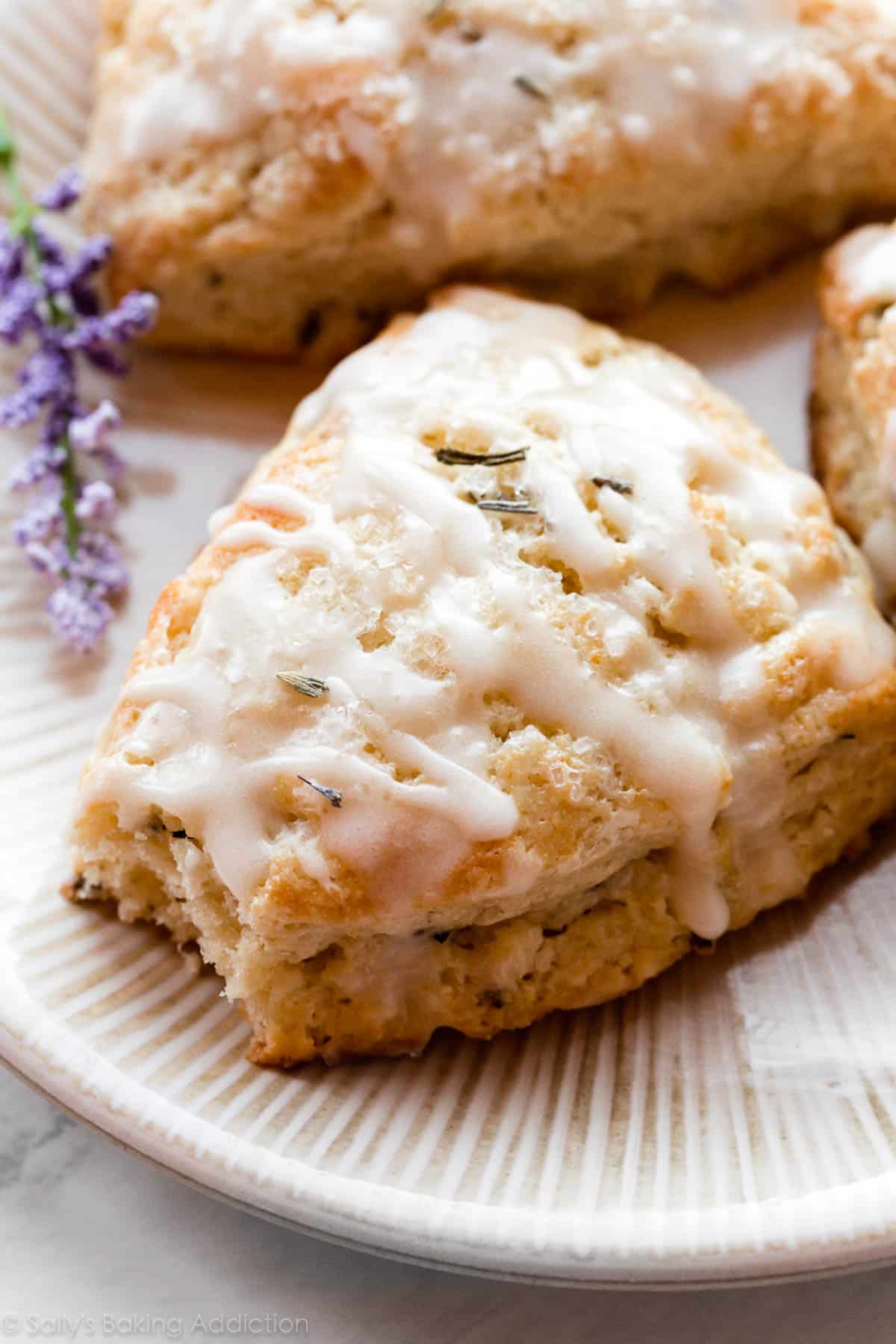
Let’s make Buttermilk Lavender Scones! But first, a briefing.
I never enjoyed floral flavors in baked goods—I mean, everything ends up tasting like hand soap or a candle. Am I alone here?!
Those were my thoughts until last year when, by the inspiration of Tessa who wrote Icing on the Cake, I tried Blackberry Lavender Cake. That day I ate my words and a fat piece of the most incredible cake to ever grace my tastebuds. Lavender, when used correctly, is DEEEEEELICIOUS.
Today I’m sharing a scone variation. Using my perfected scones recipe, I added fresh lemon zest and cooking lavender, swapped heavy cream for tangy buttermilk, and topped the scones with lemon lavender icing. These better-than-the-bakery scones are flaky and moist in the centers with crisp crumbly edges. The fresh spring flavors are completely divine and, thankfully, there’s not a trace of hand soapy flavor detected. 😉
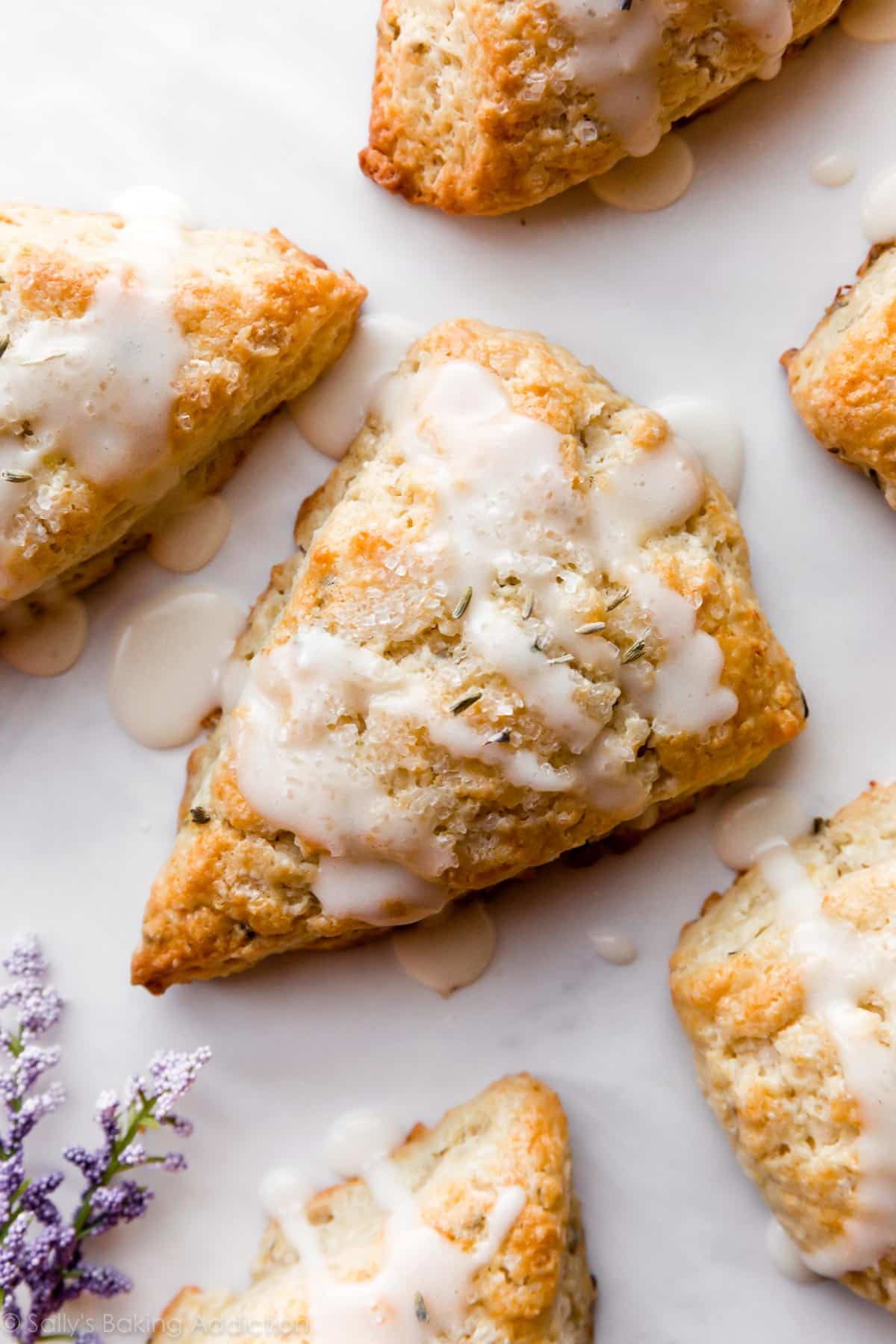
These Buttermilk Lavender Scones Are:
- Filled with bright lemon zest
- Lightly flavored with lavender
- Moist & soft inside
- Crumbly on the edges
- Buttery & flaky
- Not dry like most scones you’re used to
Use My Popular Scone Recipe
I have several scone recipes that begin with the same basic recipe. Have you ever tried my blueberry scones or chocolate chip scones? Those are two reader favorites. You only need 10 ingredients for today’s lavender scones.
- Flour: 2 cups of all-purpose flour is my standard amount, but set extra aside for the work surface and your hands as you shape the scones.
- Sugar: Use 1/2 cup of sugar for this scone dough.
- Baking Powder: Adds lift.
- Salt: Adds flavor.
- Lemon Zest: Adds more flavor.
- Dried Culinary Lavender: Make sure you’re using the correct dried culinary lavender. (More on this crucial ingredient below.) You won’t bite into coarse pieces of dried lavender, though—they’re broken down when you cut the butter into the dough.
- Butter: Besides flour, butter is the main ingredient in scones. It’s responsible for flakiness, flavor, crisp edges, and rise.
- Buttermilk: For the best tasting scones, stick with a thick liquid such as heavy cream or buttermilk. I usually use heavy cream, but I craved a slightly tangy flavor with the lavender, so I reached for buttermilk.
- Egg: Adds flavor, lift, and structure.
- Vanilla Extract: Vanilla extract adds flavor.
Scones Video Tutorial
Here’s a 5 minute video demonstrating the process. I’m making blueberry scones in this video, but the process is the same. For these lavender scones, you’ll add lemon zest and lavender to the dry ingredients and swap heavy cream for buttermilk.
Frozen Grated Butter – The Secret in These Lavender Scones
Did you know that keeping scone dough as cold as possible prevents over-spreading? (Same thing with cookie dough!) When scones over-spread in the oven, they lose the flaky, moist, and deliciously crumbly texture. The easiest way to avoid disaster is to use cold ingredients like cold buttermilk, egg, and butter. Don’t waste your time and money by overlooking this!
However, frozen + grated butter is the secret to real scone success. Like we do when making pie crust, work the cold butter into the dry ingredients to create crumbs. The butter/flour crumbs melt as the lavender scones bake, releasing steam and creating air pockets. These pockets create a flaky center while keeping the edges crumbly and crisp. Refrigerated butter might melt in the dough as you work with it, but frozen butter will hold out until the oven. And the finer the pieces of cold butter, the less the scones spread and the quicker the butter mixes into the dry ingredients.
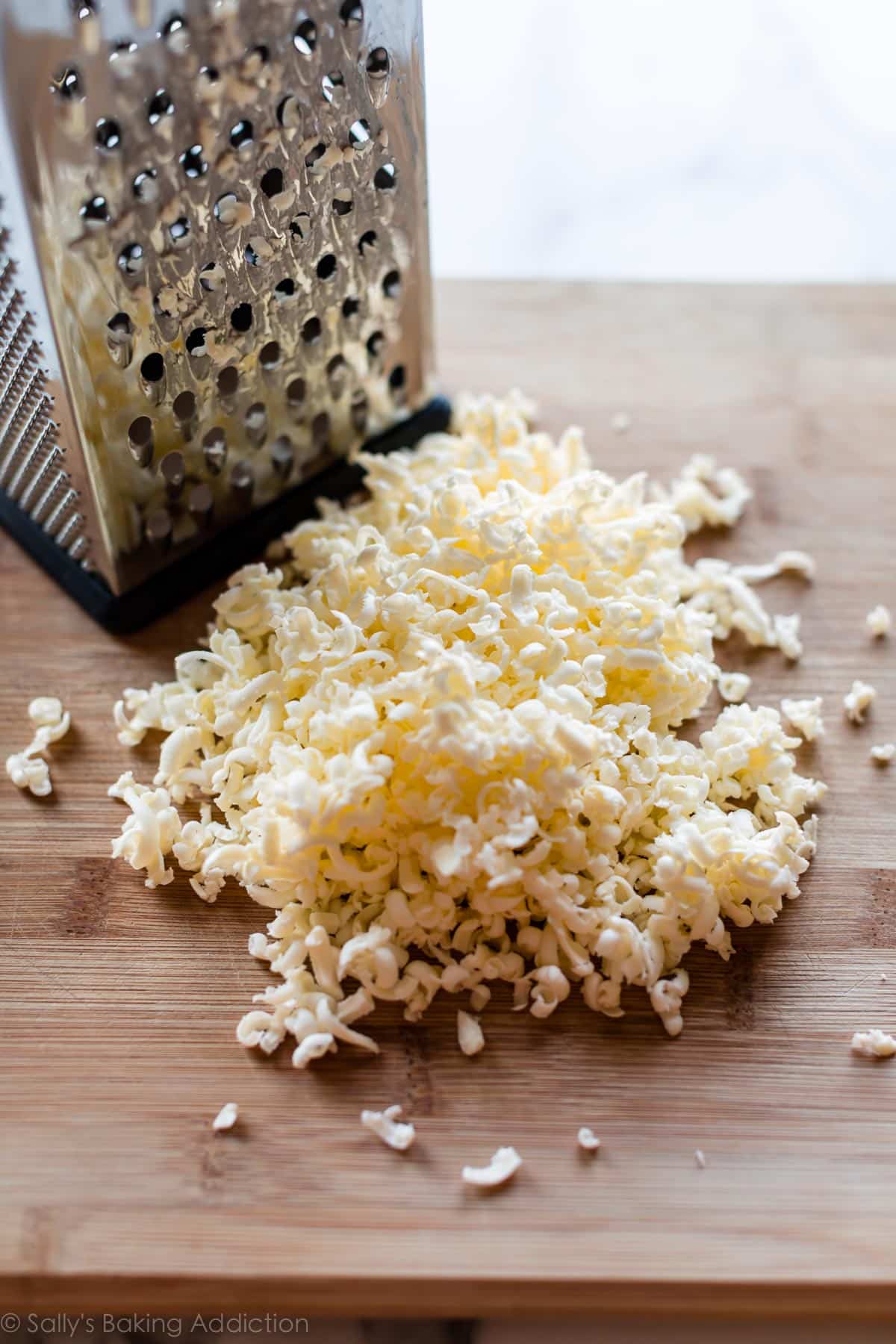
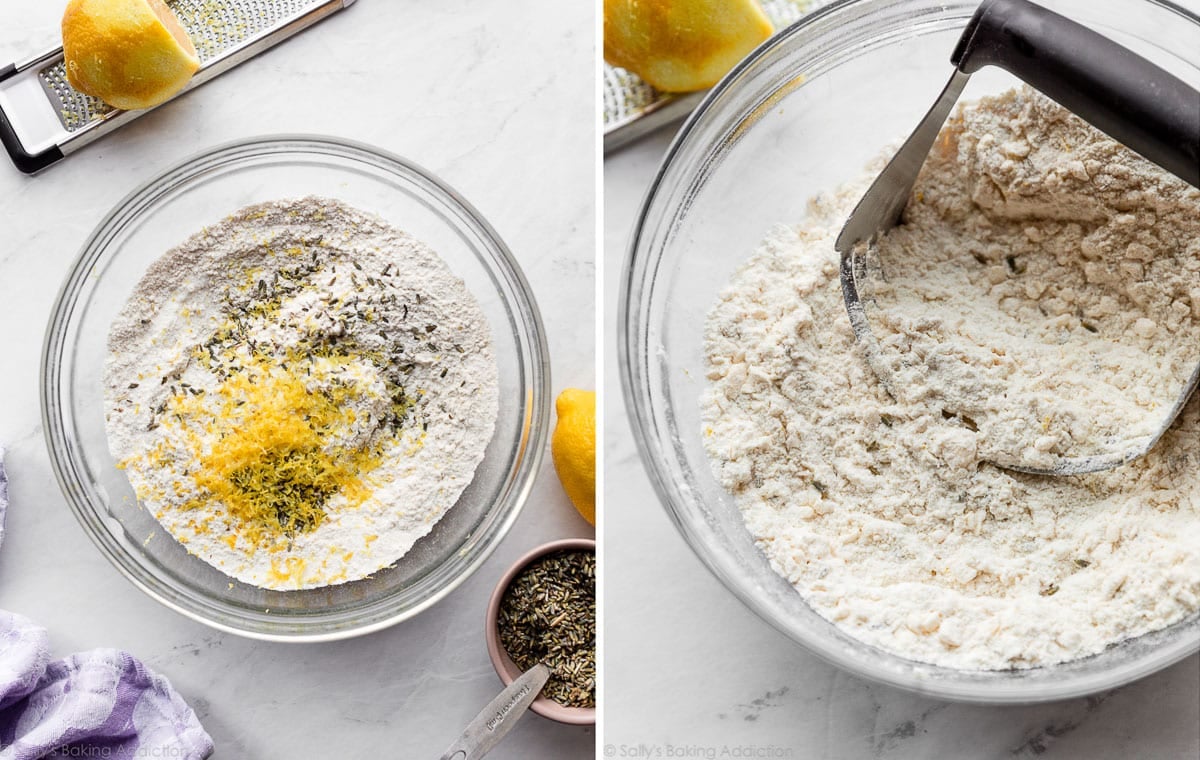
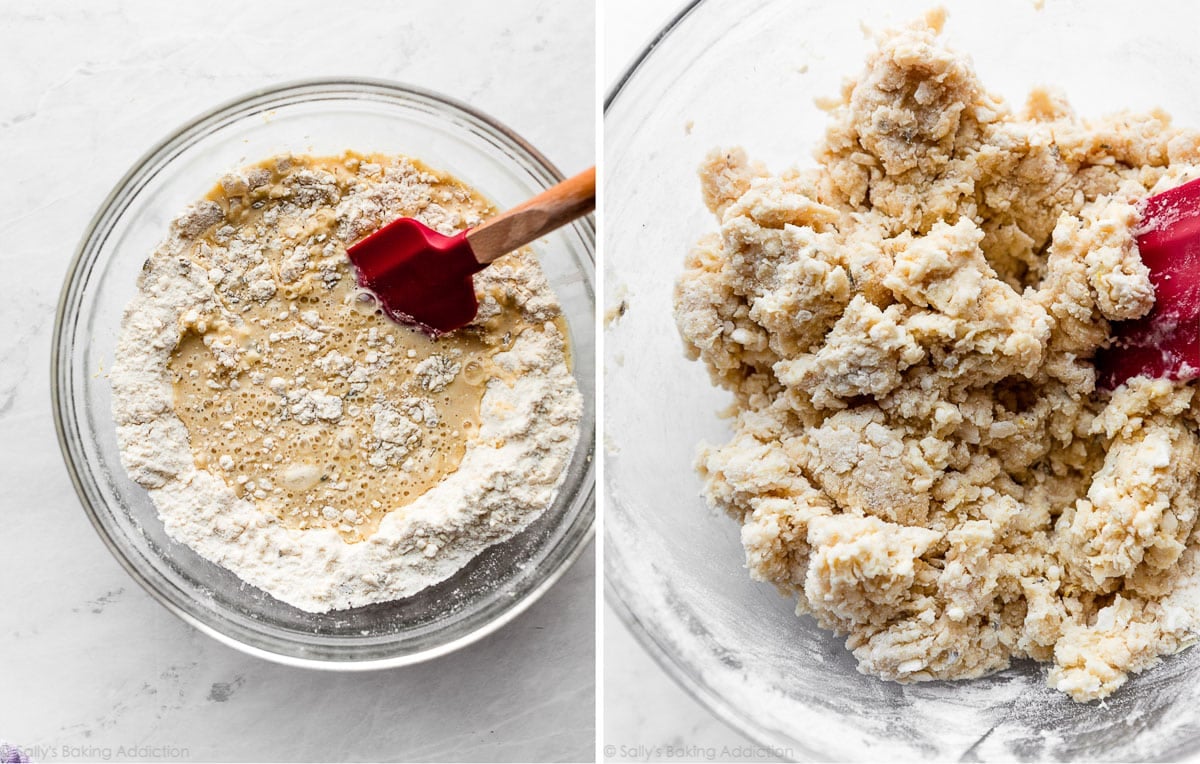
Best Lavender to Use for Lavender Scones
There’s a fine line between eating a deliciously flavored lavender treat and eating potpourri. And up until recently, I was totally new to cooking with lavender. You might be too, so let me help you determine the best lavender to use here. This multi-use dried culinary lavender is perfectly edible and a wonderful addition to food, drinks, essential oils, and more. It’s exactly what I use when I make lavender scones.
Baker’s Tip: When transferring the sticky shaped scones from your work surface to the lined baking sheet, use a thin spatula. This is where the scones can fall apart, but a thin spatula helps seamlessly transfer the dough around.
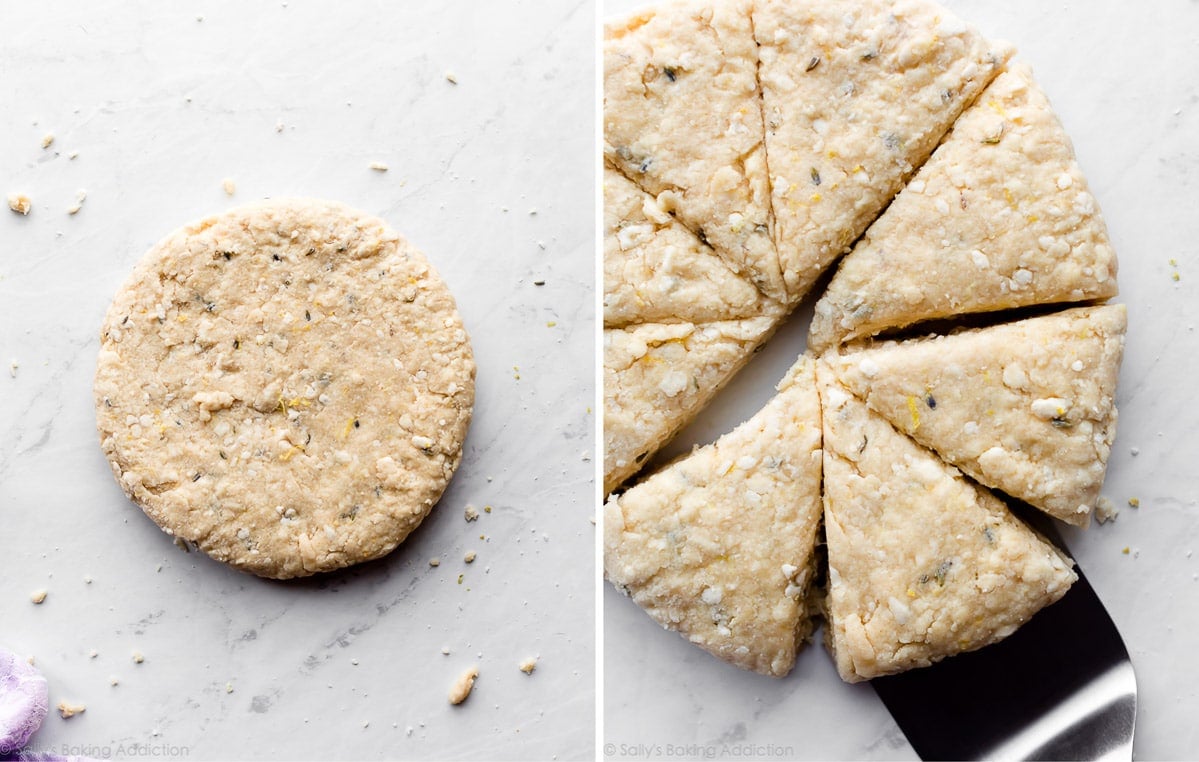
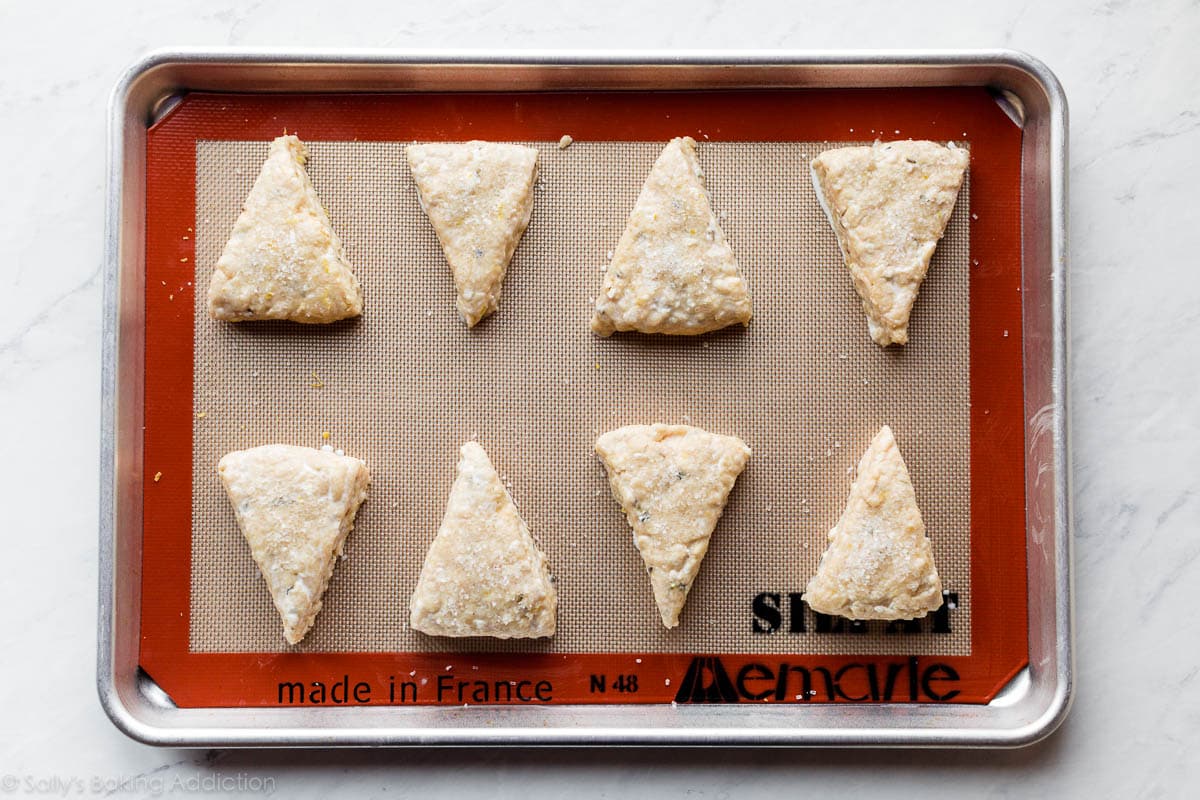
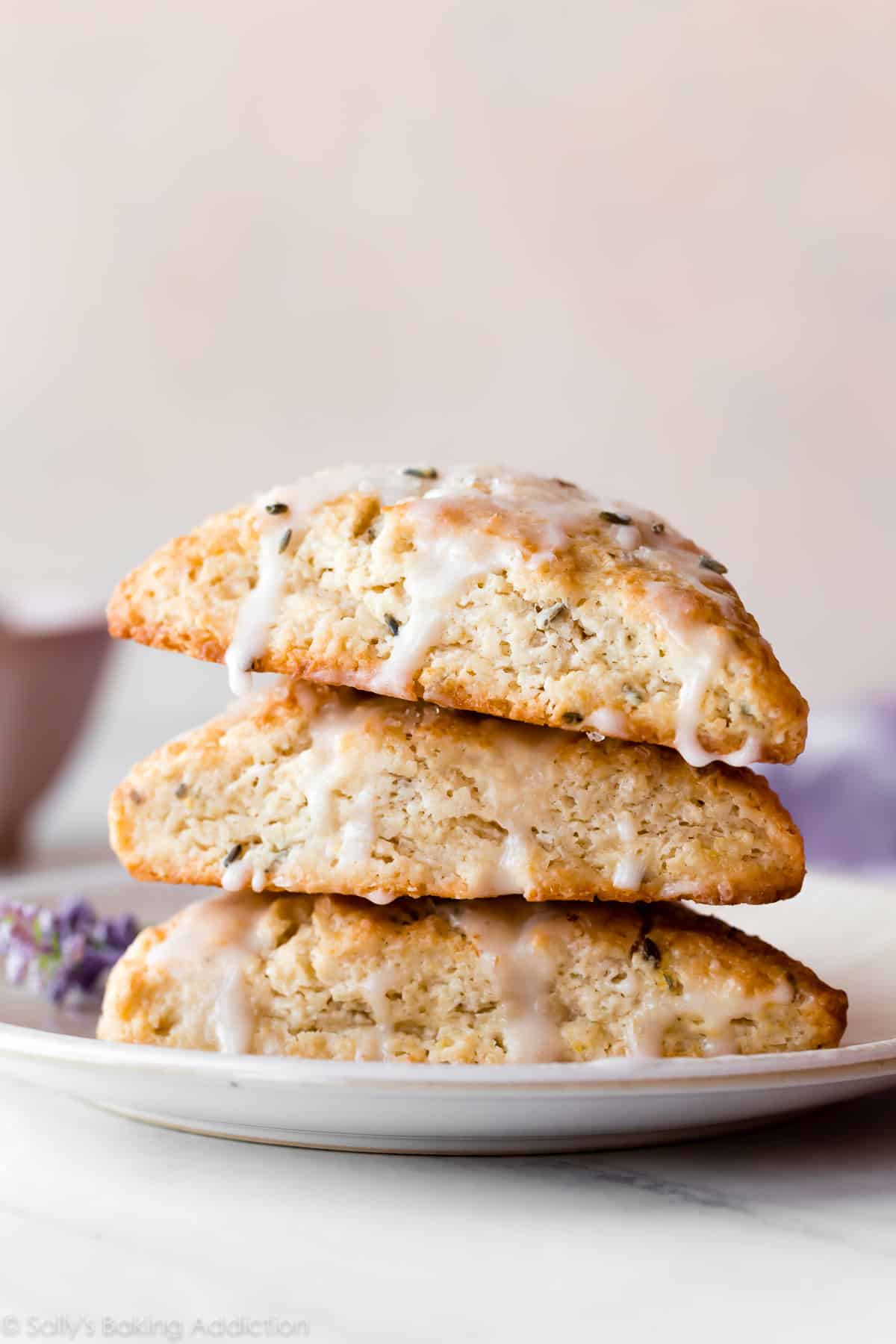
Lavender Scones Icing
Since the lavender flavor is so light in the scones themselves, using lavender again in the icing makes sense. The best way to make lavender icing is to infuse the liquid ingredient (milk) with plenty of lavender flavor. Bring milk to a simmer, then let it steep with 1 teaspoon of dried cooking lavender. Strain the lavender through a fine mesh strainer, then whisk the infused milk with a little lemon juice and confectioners’ sugar. The icing is way easier than it sounds!
If you don’t have a fine mesh strainer (affiliate link to my favorite set), pick one up. You’ll use it a lot in your baking, especially when a recipe calls for a sifted ingredient.
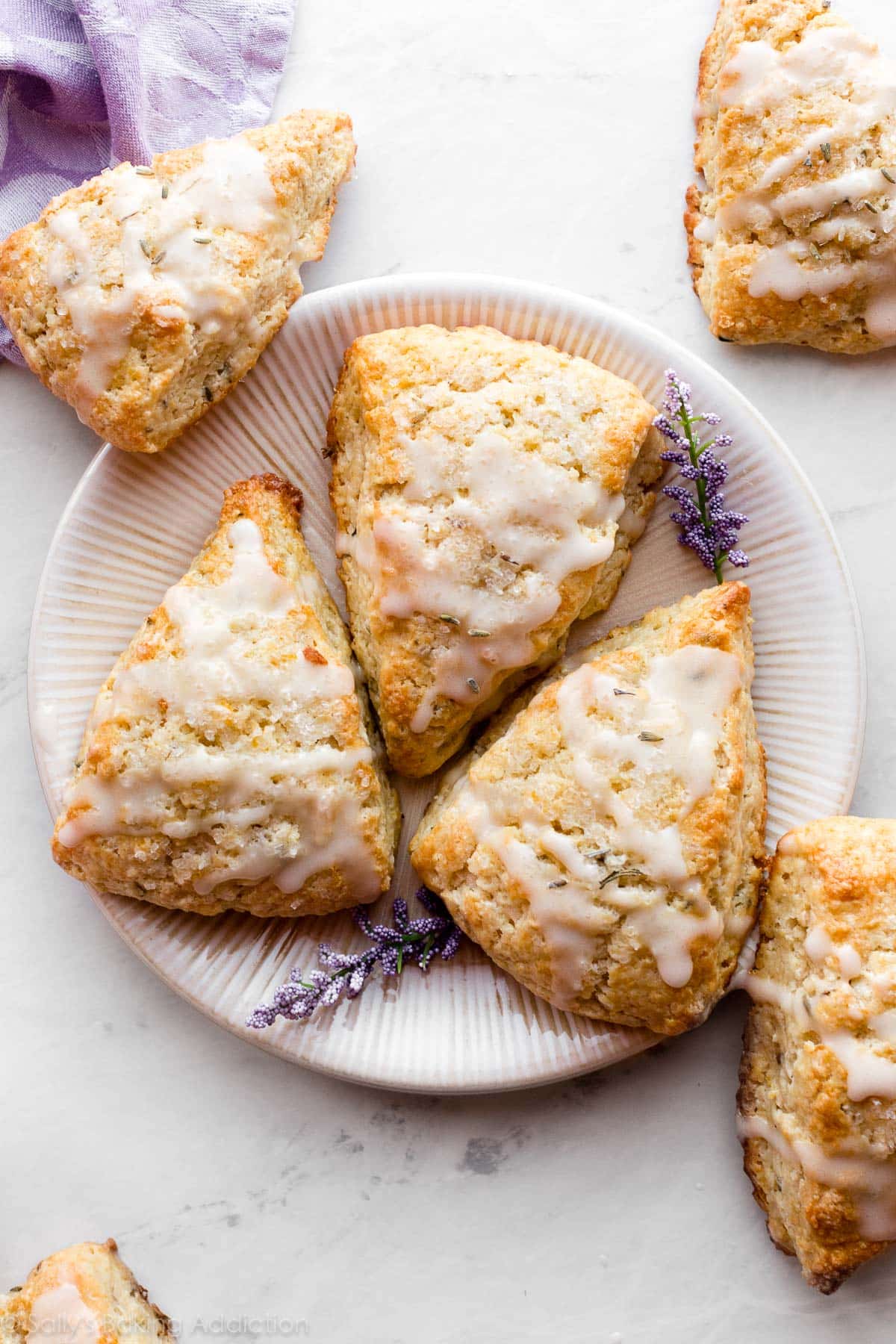
I know you’ll love these!
Print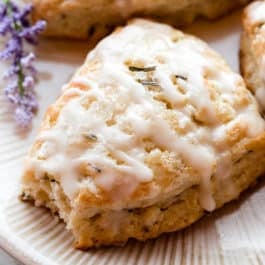
Lavender Buttermilk Scones
- Prep Time: 45 minutes
- Cook Time: 25 minutes
- Total Time: 1 hours, 15 minutes
- Yield: 8 large or 16 small scones
- Category: Breakfast
- Method: Baking
- Cuisine: American
Description
Using my favorite scones recipe, you can make bakery-style lavender scones right at home. They’re buttery and moist with crisp crumbly edges and soft flaky centers. Read through the recipe before beginning. You can skip the chilling for 15 minutes prior to baking, but I highly recommend it to prevent the scones from over-spreading.
Ingredients
- 2 cups (250g) all-purpose flour (spooned & leveled), plus more for hands and work surface
- 1/2 cup (100g) granulated sugar
- 2 and 1/2 teaspoons baking powder
- 2 teaspoons dried culinary lavender
- 2 teaspoons lemon zest
- 1/2 teaspoon salt
- 1/2 cup (8 Tbsp; 113g) unsalted butter, frozen
- 1/2 cup (120ml) buttermilk, plus 2 Tablespoons (30ml) for brushing
- 1 large egg
- 1 and 1/2 teaspoons pure vanilla extract
- optional: coarse sugar for topping
Lemon Lavender Icing
- 3 Tablespoons (45ml) heavy cream or milk
- 1 teaspoon dried culinary lavender
- 1 Tablespoon (15ml) fresh lemon juice
- 1 and 1/4 cups (150g) confectioners’ sugar
Instructions
- Whisk flour, sugar, baking powder, lavender, lemon zest, and salt together in a large bowl. Grate the frozen butter using a box grater. Add it to the flour mixture and combine with a pastry cutter, two forks, or your fingers until the mixture comes together in pea-sized crumbs. See video and photo above for a closer look at the texture. Place in the refrigerator or freezer as you mix the wet ingredients together.
- Whisk 1/2 cup buttermilk, the egg, and vanilla extract together in a small bowl. Drizzle over the flour mixture, then mix together until everything appears moistened.
- To make triangle scones: Pour onto the counter and, with floured hands, work dough into a ball as best you can. Dough will be sticky. If it’s too sticky, add a little more flour. If it seems too dry, add 1 more Tablespoon buttermilk. Press into an 8-inch disc and, with a sharp knife or bench scraper, cut into 8 wedges. For smaller scones, press dough into two 5-inch discs and cut each into 8 wedges. To make 10-12 drop scones: Keep mixing dough in the bowl until it comes together. Drop scones, about 1/4 cup of dough each, 3 inches apart on a lined baking sheet.
- Brush scones with remaining buttermilk and for extra crunch, sprinkle with coarse sugar. (You can do this before or after refrigerating in the next step.)
- Place scones on a plate or lined baking sheet (if your fridge has space!) and refrigerate for at least 15 minutes.
- Meanwhile, preheat oven to 400°F (204°C).
- Line a large baking sheet with parchment paper or silicone baking mat(s). If making mini or drop scones, use 2 baking sheets. After refrigerating, arrange scones 2-3 inches apart on the prepared baking sheet(s).
- Bake for 18-26 minutes or until golden brown around the edges and lightly browned on top. Larger scones take closer to 25 minutes. (Tip: I like to start the icing while the scones cook so the milk has a chance to steep.) Remove from the oven and cool for a few minutes before icing.
- Make the icing: In a small saucepan over low heat, bring the milk to a simmer. Remove from heat and immediately add the lavender. Set aside to steep for 15 minutes. Strain the milk through a fine-mesh sieve set over a bowl, then discard the lavender. Cool for 5 minutes. Whisk in the lemon juice and confectioners’ sugar. Feel free to add more confectioners’ sugar to thicken, if desired. Drizzle over warm scones. Icing can be made 1-2 days ahead and stored in the refrigerator.
- Leftover scones keep well at room temperature for 2 days or in the refrigerator for 5 days.
Notes
- Freeze Before Baking: Freeze scone dough wedges on a plate or baking sheet for 1 hour. Once relatively frozen, you can layer them in a freezer-friendly bag or container. Bake from frozen, adding a few minutes to the bake time. Or thaw overnight, then bake as directed.
- Freeze After Baking: Freeze the baked and cooled scones before topping with icing. I usually freeze in a freezer-friendly bag or container. To thaw, leave out on the counter for a few hours or overnight in the refrigerator. Warm in the microwave for 30 seconds or on a baking sheet in a 300°F (149°C) oven for 10 minutes.
- Overnight Instructions: Prepare scones through step 4. Cover and refrigerate shaped scones overnight. Continue with the recipe the following day.
- Special Tools (affiliate links): Glass Mixing Bowls | Box Grater | Pastry Cutter | Bench Scraper | Baking Sheet | Silicone Baking Mat or Parchment Paper | Pastry Brush | Citrus Zester | Citrus Juicer | Fine Mesh Sieve
- Over-spreading: Start with very cold scone dough. Expect some spread, but if the scones are over-spreading as they bake, remove from the oven and press back into its triangle shape (or whatever shape) using a rubber spatula.
- Lemon: 1 medium lemon is plenty for the zest and juice you need for this recipe (zest for the dough and juice for the icing).
- Buttermilk: You can substitute heavy cream for buttermilk if desired. Acidic buttermilk isn’t needed in order for the scones to rise since we’re using baking powder. However if you’d like the tangy flavor you can make your own sour milk substitute. Add 1 teaspoon of fresh lemon juice or white vinegar to a liquid measuring cup. Add enough milk to make 1/2 cup. Whisk together, then let sit for 5 minutes before using in the recipe. For the extra 2 Tablespoons needed for brushing on top of the scones, you can use regular milk or heavy cream. Whole milk is best for the DIY sour milk substitute, though lower fat or nondairy milks work in a pinch. (The scones will spread more if using lower fat or nondairy milks.)
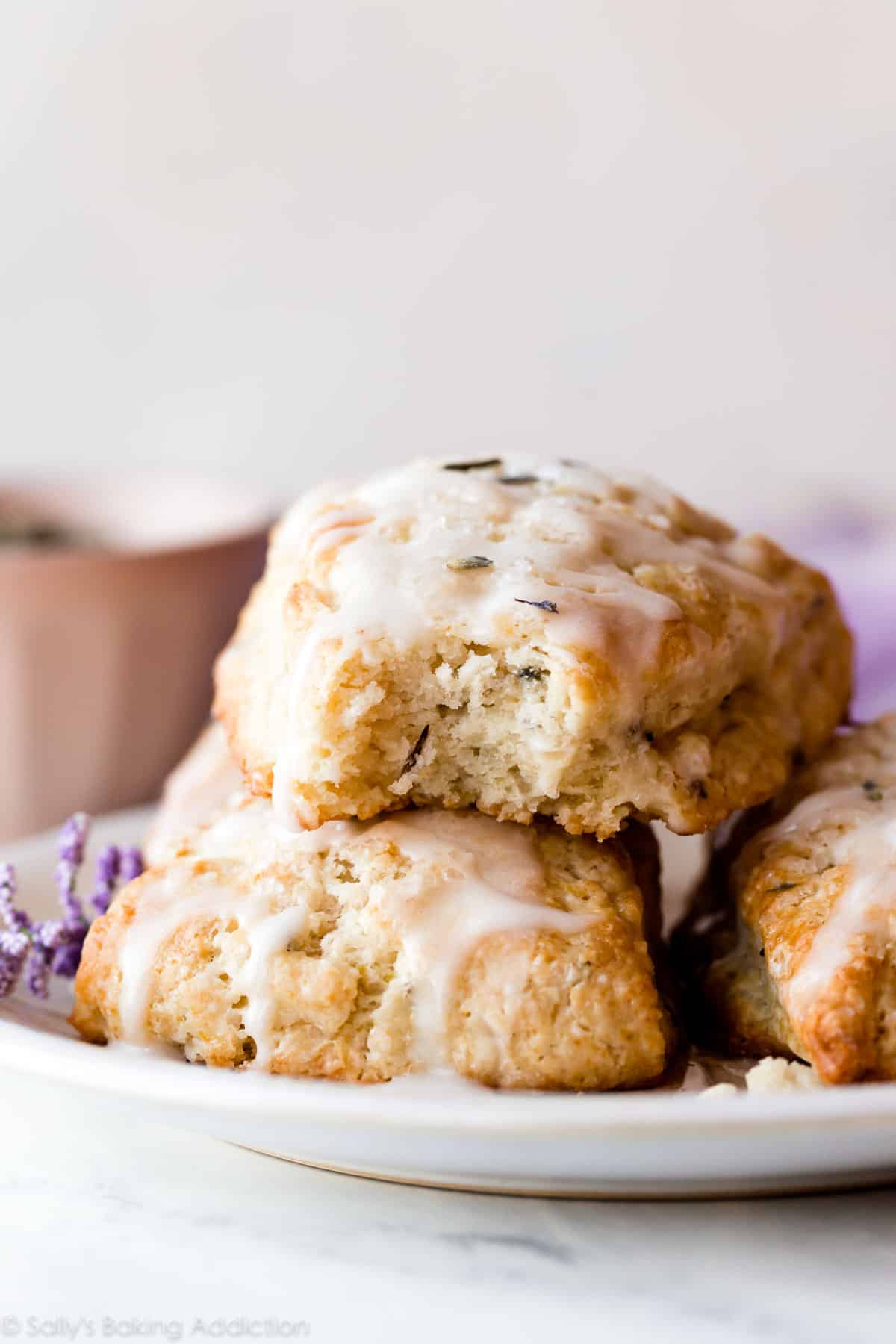



















So tasty! I’m wondering for next time – could I use honey instead of sugar? I love the flavor combo of honey and lavender, but I’m not sure if the substitution would work in terms of baking chemistry.
Hi Tara! I don’t recommend honey in this scone dough. A dry sugar is best!
Oh dear Mama… these are perfect! I’m not a baker but I had some culinary lavender and decided to try this recipe. I watched the tutorial and followed Sally’s advice about frozen grated butter and keeping the dough cold. These scones are better by far than any I’ve had at a bakery, and they’re quite easy!! Planning on making more tomorrow!!!
Pretty good results but can’t really taste the lavender and our scones didn’t rise much. Still, a tasty option for breakfast.
ABSOLUTELY DELICIOUS. just made this and wow. Perfection.
Hi! Can you add blueberries and/or strawberries to this recipe?
Yes, feel free to add between 1 and 1.5 cups of berries. Enjoy!
I LOVE scones, and these are the best scones by far! Fantastic recipe and tips to making them crunchy on the outside, moist on the inside, and packed with wonderful flavor!
These are some of the BEST scones I’ve ever made. The recipe is perfect!! Will be making these regularly this summer!
This is going to be my go to scone recipe. I made it without the lavender since I didn’t have any and they were delicious lemon scones!! Tomorrow I am going to add some blueberries or some cinnamon chips. I can see all kinds of delightful scones coming from this recipe. Thank you.!!!!
OMG SO AMAZING!! I came across this recipe while we have been in lockdown. I ordered culinary lavender from Etsy. I did made a few tweaks by cutting the buttermilk to a 1/3 cup and added 3 T (1.5oz) lemon juice into the dough mixture. I also added an extra T. of heavy cream and lemon juice to the icing mixture. I was nervous using lavender for fear of it tasting more like soap, but I am beyond pleased with this recipe! Thank you so much for sharing!!
Sally, these were amazing! I’ve never tried scones before, but they turned out beautifully. The fragrance in my kitchen is heavenly! My family loved them. I will definitely make again. Thank you!
Hi, I have some lavender extract on hand from some other recipe and just can’t find an use for it. Can I use it for these scone recipe and if so how much. These look so yummy, thanks for another great recipe.
I really want to try these but dont have lemon. Would I be able to substitute lemon zest/juice for lemon extract?
Absolutely! I recommend anywhere between 1/2 – 1 teaspoon lemon extract. (It’s pretty potent!)
The blueberry scones are fantastic! I will add more blueberries next time, not caring if they fall apart . The dough, the texture, the taste…all lovely. You nailed it with your tips, thank you! Never had such a great texture in a scone before.
I made these + the lemon lavender glaze. Mmmmm… so wonderful! I made 16 small scones and froze them so that I can have a fresh scone every day (I’m working my way through all your flavors 🙂 ). I even bake my frozen scone in the toaster oven (reduced the temp to 375 and bake for about 19 minutes). I’ve never used lavender before, but it’s lovely. I’m also using it in my tea now. Thanks for a wonderful recipe!
Delicious! This was my first time using lavender. I’ve always been afraid to try it. This recipe changed me! Great taste without it being overwhelming. I noticed that the day after I made the scones the lavender flavor mellowed and had almost disappeared. Is this typical?
Can heavy cream be used instead of buttermilk if this is tough to find at the store right now? What do you feel would be the impact since heavy cream is used for your other scone recipes? Thanks for the advice, really looking forward to trying this recipe!!!
Yes! No real difference except you lose a very slightly tangy flavor. I use the two interchangeably in my scone recipes.
Fantastic! Thanks for the quick reply – love your recipes, they are so clear and easy to follow… you make it seem like anything is doable, even for us “basic cooks.” I’ll let you know how they turn out .
These scones were amazing!
These were perfect with my tea on this sunshiney, quarantine day! Thanks so much for sharing!
Sally,
Can I use lavender paste instead of dry lavender? How much should I use?
Thank,
Hi Jeanne! I’ve never used lavender paste before but since it’s more concentrated, I recommend reducing the amount to 1 teaspoon. You can whisk it with the wet ingredients.
Made these scones this morning. What a refreshing scone! Love all your recipes Sally and you are so good at making the instructions clear and percise.
As Always, thank you!
Cheryl
I have made your blueberry scones in the past and they are wonderful! I have to admit I was a bit skeptical of the lavender amounts but found them to be perfect! My husband loves these now, too! I made the drop scones using a large scoop and it worked beautifully.
Thank you for a great recipe!
Made it and loved it! I passed these out to 7 people, and they all loved them and said make them again. Who knew Lavender would be so good in scones. Thanks Sally!!!
Can fresh lavender be used?
I recommend culinary lavender instead of fresh to ensure it hasn’t been treated with chemicals.
These are amazing!
these scones are delicious — and you’re right – way better than any coffee shop scone. but…I didn’t really taste the lavender in the scone or the icing. i may add some more the next time?? i bought the lavender at my local spice shop. it’s a pretty great gourmet shop so I trust their ingredients…oh well, I ate 2 already – damn good!!!!
I made these and they taste great, but how do you get the icing to be so white? Mine was transparent when it dried
Hi Annette! You can add a little extra confectioners’ sugar to thicken the icing if you’d like. Thicker icing won’t melt into the scones or become clear.
Hi Sally,
I’ve never baked scones – have been a little intimidated by them – but your clear instructions, helpful tips (especially about the butter), and gorgeous pictures have inspired me to try! I just ordered the lavender through your link. I would be interested in your thoughts on using organic dried lemon peel or organic lemon crystals in place of the lemon zest. The lemons I get locally don’t look that great and I wonder about the use of pesticides on them. I can’t wait to try these as soon as the French lavender arrives! Thank you!
Hi Sally- love scones and Lavender. So l made these yesterday. Yummy! loved the grated butter, It made the process so easy. A tip I found years ago when working with lavender- put the lavender in a food processor with the sugar. It chops up the lavender and infuses the sugar with the flavor. I do this every time I bake with lavender. Happy baking!
Retracting my earlier comment about the lavender not being strong enough. They just needed to cool. Taste is brilliant and just the right amount of lavender
Thanks Sally!!!
I was wondering can you use lavender paste in place of the dried lavender? If so how much.
Hi Stacey! I’ve never used lavender paste before but since it’s likely more concentrated, I recommend reducing the amount to 1 teaspoon. You can whisk it with the wet ingredients.
Thanks for the recipe! Lavender is one of my favorite flavors. How do you think I can substitute food grade lavender oil for the dried lavender?
Hi Marian! I haven’t tried it– just the dried culinary lavender. I would look up the possible substitution amounts or, at the very least, start with just a little bit at a time. Oils are quite potent.
I have a lavender paste I use for ice cream – a little more concentrated, how do you think that would work as a substitute? The ice cream is awesome, I too was reluctant as it seemed it would make it taste like a flower.
Love your website, I use your recipes all the time!
Hi Beth! I’ve never used lavender paste before but since it’s more concentrated, I recommend reducing the amount to 1 teaspoon. You can whisk it with the wet ingredients.